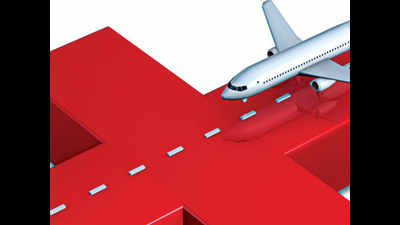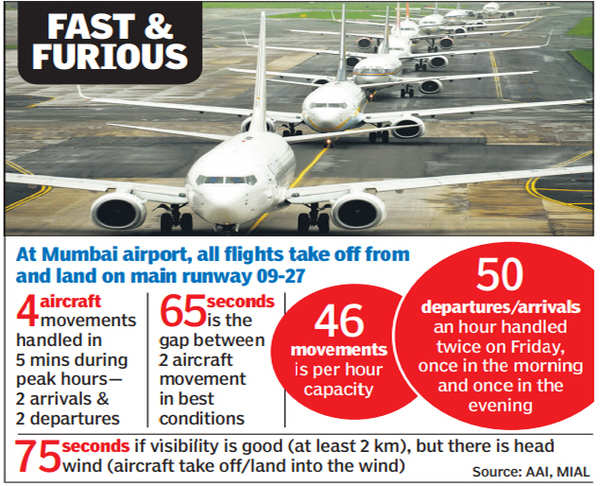- News
- City News
- mumbai News
- In 24 hours, Mumbai airport handles 969 flights; sets new world record
Trending
This story is from November 26, 2017
In 24 hours, Mumbai airport handles 969 flights; sets new world record
At Mumbai airport, all flights take off from and land on main runway 09-27. The record high air traffic movement (take-offs and landings) happen on days when the number of unscheduled flights - charter aircraft, private aircraft - go up.

File Photo
Key Highlights
- At Mumbai airport, all flights take off from and land on main runway 09-27
- The record high air traffic movement (take-offs and landings) happen on days when the number of unscheduled flights - charter aircraft, private aircraft - go up.
MUMBAI: Creating a new world record for single-runway operations, Mumbai airport handled 969 take-offs and landings in 24 hours on Friday. It broke its own record of 935, said a Mumbai International Airport Ltd spokesperson (MIAL).
Mega cities such as New York, London, Dubai and Delhi have airports with two or more runways that operate simultaneously. Though Mumbai has two runways, they criss-cross each other, so only one runway is used at a time.Technically this puts Mumbai in the single-runway airport category. So it's in the league of busy single-runway secondary airports of cities like London (Gatwick, Stansted airports), Istanbul (Sabiha Gokcen airport) and major airports of smaller cities like San Diego (US), Fukuoka (Japan) and Xiamen (China).
Mumbai handles over 900 airline flights per day. The record high air traffic movement (take-offs and landings) happen on days when the number of unscheduled flights-charter aircraft, private aircraft-go up, like it did on Friday. These flights are banned during the morning and evening peak hours, so when the load goes up during non-peak hours, new records are set. "We hope to cross 1,000 aircraft movements per day soon,'' the MIAL official said.
In civil aviation, the norm is to record time in UTC (Coordinated Universal Time, same as GMT) and Indian Standard Time is five-and-a-half hours ahead of UTC. The feat was achieved from 5.30am on Friday to 5.30am on Saturday.
"The second a landing aircraft crosses the beginning of the runway to the second when it exits the runway is recorded. Similarly, take-offs too are recorded and the data is shared with airlines on a weekly basis,'' an airport official. Every upgrade of the runway and taxiway infrastructure, change in operational practices aims to reduce the runway occupancy time (ROT).
Kapil Kaul of Centre for Asia Pacific Aviation (CAPA), a global aviation consultancy firm, says: "Gatwick is the only single-runway airport in the world that routinely handles more than 50 flight movements in a given hour. All others are 42 or less. Mumbai has the second highest as it crosses 50.''
A senior air traffic controller said: "Mumbai main runway's best so far is 52 arrivals or take-offs in 60 minutes.'' Gatwick has touched 55-56, he adds. "But there are times when we get the right mix of aircraft and weather conditions and we have handled 10 take offs or landings in 10 minutes,'' he says. A "right mix" is when the wind speed and visibility is good, all the aircraft involved are either A320s or B737s (similar speed and weight aircraft, that is), all are manned by pilots who are well-versed with the layout of Mumbai airport. Also, the departures should be such that they are in left-right-left pattern, which means one departure to north, followed by one to South, then to North and vice-versa. That's because departures to North turn right after lift off, those to South turn left and so adequate spacing between aircraft is automatically maintained.

Mega cities such as New York, London, Dubai and Delhi have airports with two or more runways that operate simultaneously. Though Mumbai has two runways, they criss-cross each other, so only one runway is used at a time.Technically this puts Mumbai in the single-runway airport category. So it's in the league of busy single-runway secondary airports of cities like London (Gatwick, Stansted airports), Istanbul (Sabiha Gokcen airport) and major airports of smaller cities like San Diego (US), Fukuoka (Japan) and Xiamen (China).
Mumbai handles over 900 airline flights per day. The record high air traffic movement (take-offs and landings) happen on days when the number of unscheduled flights-charter aircraft, private aircraft-go up, like it did on Friday. These flights are banned during the morning and evening peak hours, so when the load goes up during non-peak hours, new records are set. "We hope to cross 1,000 aircraft movements per day soon,'' the MIAL official said.
In civil aviation, the norm is to record time in UTC (Coordinated Universal Time, same as GMT) and Indian Standard Time is five-and-a-half hours ahead of UTC. The feat was achieved from 5.30am on Friday to 5.30am on Saturday.
Mumbai's demand for air travel coupled with land-shortage (which means it will never have a parallel runways) has forced the private airport operator, the government-run air traffic control and airline pilots to eke out every second worth of efficiency from the 12,008 feet long main runway 27. The runway has a declared capacity to handle 46 take-offs and departure in an hour. Twice on Friday-once in the morning and once in the evening-the runway handled 50 movements in 60 minutes.
"The second a landing aircraft crosses the beginning of the runway to the second when it exits the runway is recorded. Similarly, take-offs too are recorded and the data is shared with airlines on a weekly basis,'' an airport official. Every upgrade of the runway and taxiway infrastructure, change in operational practices aims to reduce the runway occupancy time (ROT).
Kapil Kaul of Centre for Asia Pacific Aviation (CAPA), a global aviation consultancy firm, says: "Gatwick is the only single-runway airport in the world that routinely handles more than 50 flight movements in a given hour. All others are 42 or less. Mumbai has the second highest as it crosses 50.''
A senior air traffic controller said: "Mumbai main runway's best so far is 52 arrivals or take-offs in 60 minutes.'' Gatwick has touched 55-56, he adds. "But there are times when we get the right mix of aircraft and weather conditions and we have handled 10 take offs or landings in 10 minutes,'' he says. A "right mix" is when the wind speed and visibility is good, all the aircraft involved are either A320s or B737s (similar speed and weight aircraft, that is), all are manned by pilots who are well-versed with the layout of Mumbai airport. Also, the departures should be such that they are in left-right-left pattern, which means one departure to north, followed by one to South, then to North and vice-versa. That's because departures to North turn right after lift off, those to South turn left and so adequate spacing between aircraft is automatically maintained.

End of Article
FOLLOW US ON SOCIAL MEDIA










